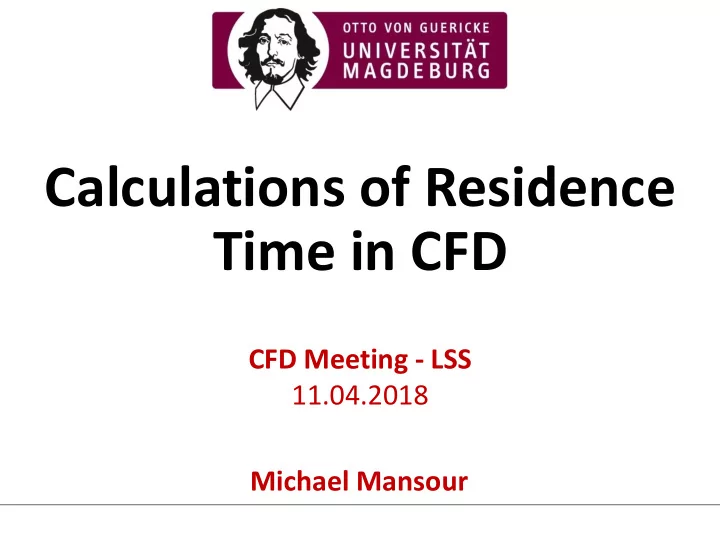

Calculations of Residence Time in CFD CFD Meeting - LSS 11.04.2018 Michael Mansour
ሶ ሶ ሶ What is Residence Time? • the time that a particle spends in a particular system 𝑛 Fluid mass (𝑛) Fluid volume (𝑊) Average time (𝜐) = (𝑛) = M ass flow rate Volume flow rate (𝑊) Not all particles (fluid elements) spend the same time in the system Calculations of Residence Time in CFD 11/04/2018 2
How to measure the Residence Time? C : concentration Calculations of Residence Time in CFD 11/04/2018 3
Why is Residence Time important? • Different RT Different process time • lower mixing • Lower heat transfer • Less homogeneous temperature distribution • Lower reaction rates Calculations of Residence Time in CFD 11/04/2018 4
What is Residence Time Distribution (RTD)? • a probability distribution function that describes the time a fluid element could spend in the system • The RTD is usually represented by a function called the exit age distribution function, E(t). 𝐷(𝑢) 𝐹 𝑢 = ∞ 𝐷 𝑢 . 𝑒𝑢 0 Calculations of Residence Time in CFD 11/04/2018 5
What is Residence Time Distribution (RTD)? Exit age distribution Cumulative function function Calculations of Residence Time in CFD 11/04/2018 6
Comparisons of (RTD) • RTD 2 is narrower than RTD 1, showing better process performance of system 1 (better mixing) Calculations of Residence Time in CFD 11/04/2018 7
How to calculate the RT in Star-CCM+? 1. For Lagrangian multiphase simulations Go to Physics 1 > Lagrangian Multiphase > Phase 1 > Models > Activate Residence Time Model Calculations of Residence Time in CFD 11/04/2018 8
How to calculate the RT in Star-CCM+? 2. For single-phase simulations Using a Passive Scalar • The passive scalar model can be used to track the accumulation of a field in the flow simulation • If the transported scalar function represents the time, then the source term should be set as the density • This attaches a virtual clock to each volume element of the fluid. Calculations of Residence Time in CFD 11/04/2018 9
How to calculate the RT in Star-CCM+? General transport equation 𝜖 𝜍𝜒 𝑊. 𝑒𝐵 = 𝑒∅ 𝜖𝑢 න 𝜍𝜒 𝑒𝑊 + න 𝑒𝑢 𝑊 𝐵 ∅: Transported quantiny (extensive property) 𝜒 → 𝑢 residence time 𝜒 : intensive property of ∅ ∅ = 𝑢 m ∅ = 𝜒 m m: mass 𝜖 𝜍𝑢 𝑊. 𝑒𝐵 = 𝑒(𝑢𝑛) = 𝑛 𝑒𝑢 𝑒𝑢 + 𝑢 𝑒𝑛 𝜖𝑢 න 𝜍𝑢 𝑒𝑊 + න 𝑒𝑢 𝑒𝑢 𝑊 𝐵 𝜖 𝜖𝑢 න 𝜍𝑢 𝑒𝑊 + න 𝜍𝑢 𝑊. 𝑒𝐵 = 𝑛 𝑊 𝐵 Calculations of Residence Time in CFD 11/04/2018 10
How to calculate the RT in Star-CCM+? Passive scalar model in Star-CCM+ 𝜖 𝜖𝑢 න 𝜍 𝜒 𝑒𝑊 + න 𝜍 𝜒 𝑊. 𝑒𝐵 = න 𝑇 𝜒 𝑒𝑊 𝑊 𝐵 𝑊 𝜖 𝜖𝑢 න 𝜍 𝑢 𝑒𝑊 + න 𝜍 𝑢 𝑊. 𝑒𝐵 = 𝑛 𝑊 𝐵 න 𝑇 𝜒 𝑒𝑊 = 𝑛 𝑊 𝑻 𝝌 = 𝝇 Calculations of Residence Time in CFD 11/04/2018 11
How to calculate the RT in Star-CCM+? 1. Activate the Passive Scalar model . 2. Create a passive scalar and rename it ResidenceTime . 3. Create a field function and rename it ResidenceTimeSource with a definition of ${Density} Or ($ResidenceTime < 10000)? ${Density} : 0 The value of 10000 represents a maximum time, which is necessary if the flow field has a vortex or recirculation. Otherwise, time would grow to infinity. 4. Select the Regions > Fluid > Physics Conditions > Passive Scalar Source Option node and select Mass flux for Source Definition . Calculations of Residence Time in CFD 11/04/2018 12
How to calculate the RT in Star-CCM+? 5. Open the Regions > [ Region ] > Physics Values node and select the Passive Scalar Source node. 6. In the Method property, select Composite . 7. Open the Composite node and select the ResidenceTime node. 8. In the Method property of the ResidenceTime node, select Field Function . 9. Select the Field Function node and set its Scalar Function property to ResidenceTimeSource , which is the field function that you defined. Calculations of Residence Time in CFD 11/04/2018 13
Example: RT for a straight pipe Sectional plane Outlet surface Calculations of Residence Time in CFD 11/04/2018 14
Example: RT for a helical pipe Outlet surface Calculations of Residence Time in CFD 11/04/2018 15
Comparison of RTD 100 100 90 90 80 80 Cumulative function F Cumulative function F 70 70 60 60 50 50 40 40 Straight pipe 30 30 Straight pipe 20 20 Helical pipe Helical pipe 10 10 0 0 0 0.25 0.5 0.75 1 1.25 1.5 1.75 2 0 1 2 3 4 5 6 7 8 Dimensionless residence time ( ϴ ) Dimensionless residence time ( ϴ ) 𝐒𝐟 = 𝟓𝟏 𝐒𝐟 = 𝟑𝟏𝟏𝟏 𝜾 = 𝒖 − 𝒖 𝒏𝒋𝒐 Straight Helical pipe pipe 𝝊 Calculations of Residence Time in CFD 11/04/2018 16
Thank you! Calculations of Residence Time in CFD 11/04/2018 17
Recommend
More recommend